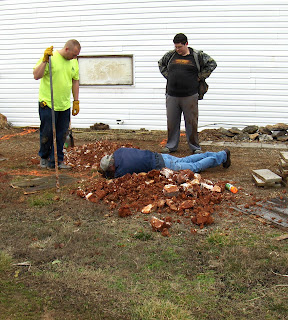It all started out almost 20 years ago, that we acquired this little girl. We've always been partial to crocodilians, of all kinds. This was traded to us, as a Nile-Cuban hybrid, by a breeder in Florida.
We kept making larger and larger enclosures for her as she grew. The last time we made an enclosure, we bought a 1000 gallon water tank, and built the enclosure around it. We used flooring that is made from recycled materials, and is virtually indestructible. We also designed it to have a feed door in the top, a wash-out in the side (for changing the water), and a door that could be opened out for when we built an outdoor enclosure for her to enjoy. The more enclosures you make, the more you learn, and improve.
I wish we had a video camera for when we attemped (and eventually succeeded) to move her from the last enclosure to where she is now. I'm sure now that a lot of what Steve Irwin did was staged, as it just is not that easy! And after you move an animal from what seemed to be a large enough enclosure, you wonder how she ever managed in what now appears to be a rather tight space. Our Yacare caiman is now enjoying that old pond, etc.
So the newest (and hopefully last) enclosure was incorporated into the side of the building with the idea that we would eventually build an outdoor spot for her to bask, etc. That was about 8 years ago, and we've finally gotten around to getting the ouside done. We did toss around several ideas, and the final solution now seems so simple, we might have done it sooner. But finances are always a concern, and none of this was inexpensive.
I had thought of writing about this in stages, but if you saw the last photo, you might not have bothered with the original blog. So here's the start of something big, and I do mean big.
I'm the one on the ground. We're digging holes for the fence posts that will eventually hold up the platform, etc, for the croc to get out on and sunbathe. Behind my "stand-up" help, you can see the hole that is the opening for the croc's indoor enclosure. We had it sealed off with insulation, etc. You can also see we have lots of rocks to contend with, when digging these holes, and one must get on their bellies to fish them out!
We had 5 holes to dig altogether. We also had to get a jackhammer to chip away at part of the foundation that stuck out too far, and was in the way of the post holes next to the building. Truly an all-day or two-, or three-day project! We decided to make it a bit over 6 feet tall, so an average person could stand upright, and get in there if the need arose, and not be cramped.
Then the flooring. We decided that rather than have an outdoor pond too, we'd just have the one pond, in the shade, so she could adjust her body temperature as she saw fit.
We elevated the floor because we have an outside drain for the inside pond, and this allows us easy access. The two posts that you see close together are for the eventual gate that we put on, again for access. The two pens you see in the background are for some small alligators that we also house. They work out very well in the summer time. Obviously they are not nearly as big as the croc. Then we put on the chain link.
Travis puts up fence for a living. We had nothing to do with that except bring him a cold drink now and then. He also put up chain link across the top of the enclosure. This is heavy duty chain link too, not what you'd find between your neighbor's house and your own. Then he installed a gate.
We had a professional welder come and fix latches that would not be opened easily by anyone or anything. But how cool would it be to put "professional builder of croc enclosures" on your resume?
If the next owners of this place want to keep a gorilla in this enclosure, they might be able to! Or a rock band that needs to be kept safe from overzealous fans. The floor is approximately 10 feet by 12 feet.
Checking us out!
So now, the big day. We gathered around, took down the insulation and plywood door cover, opened up the plexiglass window from the inside...and waited...and waited...and waited... I hosed down the floor as I thought it might have been too hot for her, and thought running water might make her take notice and want to investigate.
Half out!
The croc is totally enjoying her new enclosure, and she freely goes in and out during the day to cool off, warm up, whatever she wants. She never went off feed, does not charged the chain link, and seems totally oblivious to our presence, although she does watch the dog intently, when the dog passes by!
I have to thank Travis, Shane, and Denney for all their hard work, and thoughtful suggestions. And how do we know it's a female? Our caiman, and alligator are large enough to bellow when she comes into heat. Every spring. Meanwhile, she never makes a sound.
Siesta time. Zzzzzzzzzzzzzzzzzzzzzz.....



































